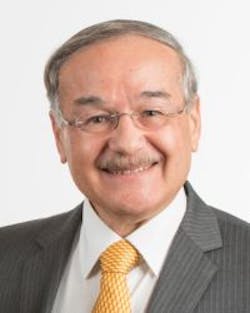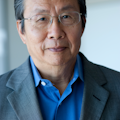Business Forum: Joining research, teaching, and entrepreneurship to advance photonics

I interviewed Dr. Bahaa Saleh because he heads one of major optics and photonics teaching colleges in the U.S. He is dean & director, professor of optics at the College of Optics and Photonics (CREOL) at the University of Central Florida (UCF). Prior to CREOL, he was the chair of the department of electrical and computer engineering (ECE) at Boston University and deputy director of the Bernard M. Gordon Center for Subsurface Sensing and Imaging Systems. His current research is in statistical and quantum optics and image science.
Milton Chang: Tell us about CREOL and UCF.
Bahaa Saleh: What you may not know is that UCF is the second largest public university in the U.S. with over 60,000 students. CREOL started in 1987 as the Center for Research and Education in Optics and Lasers and became the College of Optics and Photonics in 2004. It is home to the Florida Photonics Center of Excellence (FPCE), the Townes Laser Institute (TLI), and the Institute for the Frontier of Attosecond Science and Technology (iFAST).
Our principal function is to educate and train the workforce that meets industry needs at a local and national level and keeps industry growing. The College (CREOL) has 31 faculty members, 55 research scientists, 158 graduate students, and 40 undergraduate students; it graduates about 20-25 PhDs and 20 MS students annually. Last year, we started a new BS program in Photonic Science and Engineering (PSE).
MC: An engineering degree in photonics?
BS: The purpose of this new engineering degree program is to prepare the next generation of engineers for the growing optics and photonics industry, which, as you know, has a broad set of applications. We have structured the curriculum to be a partnership with the College of Engineering and Computer Science, and it is expected to be accredited as an engineering degree.
MC: What would a degree in photonics add? Most of us do not feel handicapped coming from electrical engineering and physics areas.
BS: The degree gives students the breadth of a general engineer with some specialization in optics and photonics. In the first two years, we introduce students to courses in electromagnetics, electronics, communication, and signal processing. Building upon this knowledge, in the junior and senior years, the students will be introduced to optics, optoelectronics, optical fiber communication, and 2D signal processing (imaging), and lasers.
One of our key strategic goals is to develop and grow this nascent BS program. We will promote a BS-MS degree aiming at providing industry with a professional engineer with optics expertise. A side benefit is an increase in MS students, which will also increase the number of PhD students to meet the planned growth of our research.
MC: What is the research focus of CREOL?
BS: Our research portfolio has three attributes: It is comprehensive, covering the optical spectrum (from THz to X-rays); it includes materials, devices, and systems; and it is a blend of basic science and engineering applications—a combination of discoveries and inventions.
Our aim is to stretch the limits of what optics can do: for example, the shortest optical pulse, the narrowest linewidth, the lowest noise, the narrowest laser spot, the highest spatial resolution, the greatest power, the highest efficiency, the lowest laser threshold, and micro- and nano-structured material or optical fibers with exotic properties, and so on.
MC: That’s pretty ambitious! Any notable accomplishments?
BS: Many of our faculty are world renowned, and their work has been impactful and highly cited. In 2013, the faculty published 190 reviewed journal papers and were issued 19 patents. In 2012, UCF was ranked by the National Academy of Inventors as ninth among U.S. public universities for patents produced, and CREOL contributed significantly to this. Five faculty were recently named members of the National Academy of Inventors. Professor Demetrios Christodoulides was named in Thomson Reuter’s 2014 list of “The World’s Most Influential Scientific Minds.”
A few examples of recent major research accomplishments are: generation of the shortest laser pulse (67 attoseconds), development of the lowest noise multi-GHz stabilized optical comb semiconductor sources, first generation of ultra-high-density spatial division multiplexing with a few-mode multicore optical fiber, discovery of a new method for fabrication of in-fiber polymeric nanoparticles, harnessing notions from parity-time symmetry to design stable single-longitudinal-mode operation in a system of coupled microring lasers, and demonstration of optically induced negative forces.
MC: How do you view the future of photonics?
BS: I am excited to see increasing public awareness of the importance of optics and photonics: the National Academies report declaring O&P essential technologies for our nation, the launching of the National Photonics Initiative, the International Year of Light and Light-based Technologies announced by the UN, and the recent announcement by President Obama of a $220 million Integrated Photonic Institute for Manufacturing Initiative (IMI). I expect this to result in increased public funding for research, and I foresee continued enhancement of photonics science and technology and applications.
MC: No doubt you will be pursuing IMI funding.
BS: Yes! Together with a number of industrial and academic partners, we are well-positioned and ready to become the anchor of an integrated photonics institute. UCF has launched a state-supported $110 million consortium for advanced manufacturing research. It is a partnership between the university, the Osceola County government, the Florida High Tech Corridor Council, Metro Orlando Economic Development Commission, and Enterprise Florida. The consortium has recently broken ground on a new high-tech manufacturing facility near Kissimmee, with an emphasis on smart sensors, both electronic and optical. Additional state support is expected.
MC: CREOL has encouraged entrepreneurship since its founding. What has been the outcome?
BS: Since we started 27 years ago, CREOL faculty have created 25 startups. The University has a strong incubation program and a research park, and CREOL hosts five incubated companies. A key ingredient for our success is our strong coupling with industry. We collaborate and partner with industry members on their technical needs.
We have a consortium of industrial affiliates, and we partner with the Florida Photonics Cluster and the Florida High-tech Corridor Council, which funds research projects driven by industry. A good portion of our external funding comes from, or through, industry. Beyond entrepreneurship, our principal function is to educate and train the workforce to aid the development of knowledge- and technology-based industries in Florida.
MC: What is your vision for CREOL going forward?
BS: After many years of state budget cuts, state funding has improved and the university is now supporting the addition of new faculty lines to shape the future of the college. This will give us an opportunity to grow in photonic sensing and imaging, nanophotonics, biophotonics, ultrafast optics, and lasers in manufacturing. All of these areas are directly or indirectly related to the initiatives in integrated-photonic advanced manufacturing and to optoelectronic smart sensors.
I also expect a stronger role for optics and photonics in medical and biological applications fostered by collaborative research with the College of Medicine. This growth is expected to attract more students, more funding, and stronger partnership with industry.
The photonics field is generating greater public and government awareness, which is expected to fuel future growth. CREOL, being one of only three colleges to offer a comprehensive program, is in a strong position to lead and support strong growth in photonics technology.
About the Author
Milton Chang
MILTON CHANG of Incubic Management was president of Newport and New Focus. He is currently director of mBio Diagnostics and Aurrion; a trustee of Caltech; a member of the SEC Advisory Committee on Small and Emerging Companies; and serves on advisory boards and mentors entrepreneurs. Chang is a Fellow of IEEE, OSA, and LIA. Direct your business, management, and career questions to him at [email protected], and check out his book Toward Entrepreneurship at www.miltonchang.com.
